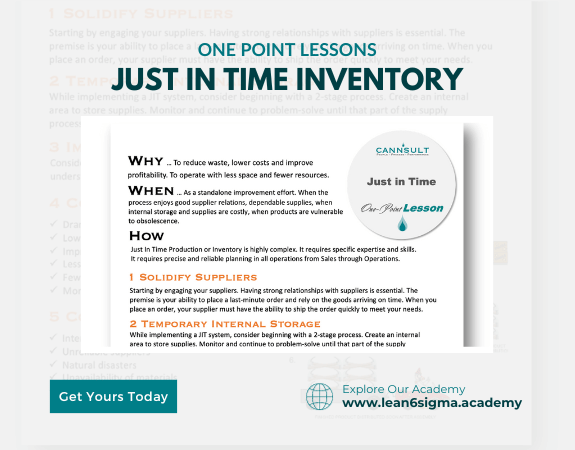Just in Time
Minimize waste
Inventory Cycles
Create a Pull system
Works together with SLA's!
JIT
Minimize Inventory
Reduce Waste!
Continuous Improvement
JIT is a streamlined inventory management approach that aims to produce and deliver goods only when needed, minimizing inventory holding costs while ensuring efficient production.
Description:
Just-in-Time (JIT) is a lean manufacturing and inventory management philosophy developed by Toyota. It focuses on eliminating waste, reducing inventory levels, and delivering products to customers precisely when needed.
Key Principles of JIT:
Inventory Minimization: JIT aims to keep inventory levels as low as possible. Excess inventory ties up capital, storage space, and resources.
Production to Demand: Produce goods or components only when there is a demand from customers. Avoid producing in excess of demand (overproduction).
Pull System: Use a pull-based system where production is initiated based on customer demand rather than pushing products into inventory.
Continuous Improvement: Continuously strive to improve processes and eliminate waste. JIT is not a one-time initiative; it's an ongoing effort.
Steps to Implement JIT:
Demand Forecasting: Accurately predict customer demand. Use historical data, market analysis, and customer feedback to inform forecasts.
Supplier Collaboration: Collaborate closely with suppliers to ensure a timely supply of materials and components when needed.
Reduce Lead Times: Minimize lead times in the production process to respond quickly to customer orders.
Small Batch Production: Implement smaller batch sizes to produce only what is needed for a specific time period.
Quality Control: Emphasize quality control at every stage of production to avoid defects and rework.
Kanban System: Use Kanban cards or signals to control production and material flow based on real-time demand.
Benefits of JIT:
Reduced holding costs for inventory
Lower capital tied up in stock
Reduced waste and excess production
Improved production efficiency
Enhanced customer responsiveness
Key Takeaway:
Just-in-Time (JIT) inventory management is a lean approach that optimizes inventory levels by producing goods only when needed. By minimizing excess inventory and focusing on customer demand, JIT improves efficiency and reduces costs.

0 Reviews
Riaan is a dynamic leader, coach, facilitator, Lean Six Sigma Master Black Belt with over 20 years of hands-on experience driving business results. Riaan is highly skilled and has worked across diverse industries internationally. With a degree in Chemical Engineering, Riaan started in the major breweries and bakeries in South Africa and was so dedicated to his work that he was often known to take his work home with him.
